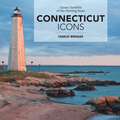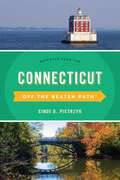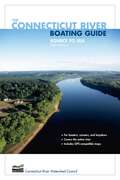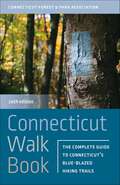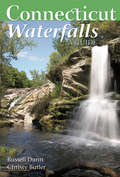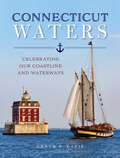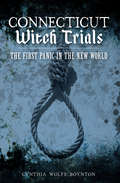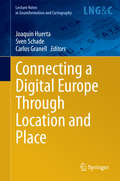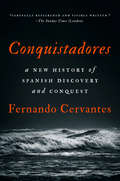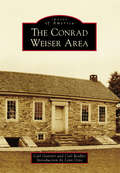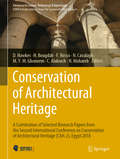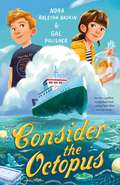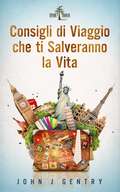- Table View
- List View
Connecticut Ghost Stories and Legends (Haunted America)
by Thomas D'Agostino Arlene NicholsonThe collaborators of A Guide to Haunted New England track the spirits of the &“Constitution State&” through its storied history. The emerald sheen illuminating the Sabbatarian burying ground, 8 Mile River&’s misty figures which emerge at the Devil&’s Hopyard, and flying demon skeletons on Charles Island—these bizarre haunts are uniquely Connecticut. In the ghostly lore of the state, the ambient ramblings of the Leatherman still ring out in the caves of Harwinton&’s forests and the former residents of the Hale Homestead continue to roam the attic at night. Join authors and Paranormal United Research Founders, Thomas D&’Agostino and his wife Arlene Nicholson, as they recount bone chilling mysteries from Putnam, Canton, New London and many more shadowy corners of the Nutmeg state. Includes photos! Praise for A Guide to Haunted New England &“Fun, charming . . . includes not only locales with reported ghosts, but also sites with macabre (though not haunted) histories.&”—True Crime Librarian &“Anyone interested in exploring the haunted, macabre and abandoned throughout New England knows they can count on D&’Agostino to find out more about the site&’s history, past sightings and how to find them.&”—Mobile RVing
Connecticut Icons: Classic Symbols of the Nutmeg State
by Charles MonaganCharles Monagan knows Connecticut. As editor of Connecticut Magazine he has spent years discovering and describing the people, places, and things that comprise the character of his home state. With this entertaining collection of photos, anecdotes, and little-known facts, Monagan presents fifty of his favorite icons—from the hot lobster roll to the Yale Bowl, the U.S.S. Nautilus to the Merritt Parkway—and shows native and newcomer alike the independent spirit and local pride at the heart of this great state of Connecticut.
Connecticut Made: Homegrown Products by Local Craftsman, Artisans, and Purveyors (Made in)
by Cynthia ParzychA unique guidebook and local resource full of hundreds of things to find and buy, crafts to discover, factories to explore, and history to uncover––all made in Connecticut. Hundreds of the state&’s top cottage industries––all places that you can shop and/or tour––are showcased. Organized by product type, categories include ceramics/pottery, clothing/accessories, furnishings/furniture, glassware, home décor, jewelry, specialty foods, toys/games, and so much more. Together, these homegrown establishments help make up the identity of the Nutmeg State and are part of the larger fabric of what is distinctively New England.
Connecticut Off the Beaten Path®: Discover Your Fun (Off the Beaten Path Series)
by Cindi D. PietrzykTired of the same old tourist traps?Whether you're a visitor or a local looking for something different, Connecticut Off the Beaten Path shows you the Nutmeg State with new perspectives on timeless destinations and introduces you to those you never knew existed.Tour the historic sites of the Thames River Heritage Park by water taxi in New London and Groton. Savor an authentic farm-to-table meal from Lost Acres Orchards in Granby.Experience hands-on fun at The Children's Museum (Hartford) or the Discovery Museum and Planetarium (Bridgeport).So if you've "been there, done that" one too many times, get off the main road and venture Off the Beaten Path.
Connecticut River Boating Guide: Source To Sea (Paddling Series)
by Connecticut River Watershed CouncilThis is the all-new edition of the Connecticut River Boating Guide, the standard resource for boaters, canoeists, and kayakers. It includes thirty-two GPS-compatible maps that together map the entire length of the river. Data for twenty-eight river reaches include information on mileage, navigability, difficulty, sources of flow information, portages, camping, USGS maps and NOAA charts, special fishing regulations, boating facilities, and more. The narrative text accompanying the maps is a mile-by-mile description of the river with detailed information on landmarks, navigational hazards, conservation, wildlife, and history. The book is authored by, and published in cooperation with, the Connecticut River Watershed Council, the leading organization devoted to management of the river and its watershed.
Connecticut Town Greens: History of the State's Common Centers
by Eric D. LehmanThe state of Connecticut has 170 town or village greens that still exist today. These greens date back to Colonial times where they served as the physical and spiritual centers for these early towns. Today many town greens continue to be the center of town events, fairs, and other gatherings. Connecticut Town Greens will explore the history of these remarkable greens and provide a guide to current events.
Connecticut Valley Tobacco
by Brianna E. Dunlap Leonard HellermanCigar tobacco runs in the blood of Connecticut River Valley farmers. Delve into the surprising history of the region's most iconic crop, all the way back to early Native American uses and the boom of the Civil War. Though fashionable in the 1950s, the popularity of cigars declined a decade later, nearly destroying the region's tobacco industry. A resurgence in the 1990s brought new life to the crop, and the reopening of Cuba in 2015 added a new chapter for cigar tobacco. Brianna Dunlap, director of the Connecticut Valley Tobacco Museum, provides a guide to important tobacco landmarks from East Haddam to Brattleboro, featuring stunning photography from Leonard Hellerman. It is the story of the people--the farmers and field hands--who made tobacco the soul of the valley.
Connecticut Walk Book: The Complete Guide to Connecticut's Blue-Blazed Hiking Trails
by Connecticut ParkLace up your boots and experience some of the best hiking in New England. Whether you are a day-tripper or long-distance hiker, old hand or novice, you'll find trails suited to every ability and interest. The Connecticut Forest & Park Association (CFPA) maintains over 825 miles of Blue-Blazed Trails in Connecticut, trails that wind through state parks and forests, land trusts, and across private land. The Connecticut Walk Book is a comprehensive guide to these trails, including detailed, full-color maps, mileage/destination tables, and a lay-flat design for ease of use. In this twentieth edition of the Connecticut Walk Book you will find descriptions of the hikes with maps that are clear and easy to read and follow, parking information, and trip-planning essentials that will bring you to every trail.Publication of this book is funded by the Beatrice Fox Auerbach Foundation Fund at the Hartford Foundation for Public Giving.
Connecticut Waterfalls: A Guide
by Russell DunnEasy access to cascades, cataracts, and more. Connecticut is rich in history, geology--and waterfalls.Bringing these together in one guide, richly illustrated by both photographs and antique postcards, this book provides not only good directions and descriptions, but also historic and stratigraphic context for these thrilling yet peaceful places. Many of CT''s waterfalls are now the centerpieces of parks and preserves--perfect for a weekend visit and picnic.
Connecticut Waters: Celebrating Our Coastline and Waterways
by Caryn B. DavisConnecticut Waters is a tribute to Connecticut&’s maritime roots both past and present. The book takes readers on a nautical journey exploring the many ways Nutmeggers use our lakes, rivers, sounds and shores for industry, education, and recreation. From boat builders, to antique, power and sailing vessels, to lobster shacks, the oyster and fishing industries, historic ferries, nautical arts, lighthouses and islands, charter boats, maritime festivals and celebrations, and more, this book showcases how these waterways have defined our culture and shaped our heritage as a state.
Connecticut Witch Trials: The First Panic in the New World
by Cynthia Wolfe BoyntonThe little-known story of the first witch hunt in New England—nearly half a century before Salem. Connecticut&’s witch hunt was the first and most ferocious in New England, occurring almost fifty years before the infamous Salem witch trials. Between 1647 and 1697, at least thirty-four men and women from across the state were formally charged with witchcraft. Eleven were hanged. In New Haven, William Meeker was accused of cutting off and burning his pig&’s ears and tail as he cast a bewitching spell. After the hanging of Fairfield&’s Goody Knapp, magistrates cut down and searched her body for the marks of the devil. In this book, through newspaper clippings, court records, letters, and diaries, former New York Times correspondent Cynthia Wolfe Boynton uncovers the dark history of the Connecticut witch trials. Includes illustrations
Connecting History: National 4 & 5 The Atlantic Slave Trade, 1770–1807
by Eleanor TrevenaExam board: SQALevel: National 4 & 5Subject: HistoryFirst teaching: September 2017First assessment: Summer 2018Fresh stories, fresh scholarship and a fresh structure. Connecting History informs and empowers tomorrow's citizens, today.Bringing together lesser-told narratives, academic excellence, accessibility and a sharp focus on assessment success, this series provides a rich, relevant and representative History curriculum.> Connect the past to the present. Overarching themes of social justice, equality, change and power help students to understand the importance of events and issues, then and now.> Go far beyond other resources. With respect and aspiration for the transformative power of History, this series incorporates the latest research, challenges old interpretations and embeds diverse experiences throughout.> Follow a clear and consistent structure. The key issues in the N5 specification form the chapters in each book, and the content descriptors are subheadings within the chapters. Finding the information that you need has never been easier.> Meet the demands of the assessments. Connecting History develops the knowledge and skills for success, with appropriate breadth, depth and pace. The narrative and sources take centre stage and the authors model the process of answering questions effectively through that narrative, ensuring that students know all the key points that they need to. End-of-chapter activities consolidate and extend learning.> Benefit from pedagogic and academic expertise. The authors are highly experienced teachers and examiners who know how to spark critical curiosity in students. Each book has been rigorously reviewed by an academic from the University of Glasgow, so you can rest assured that the content is accurate and up to date.
Connecting History: National 4 & 5 The Atlantic Slave Trade, 1770–1807
by Eleanor TrevenaExam board: SQALevel: National 4 & 5Subject: HistoryFirst teaching: September 2017First assessment: Summer 2018Fresh stories, fresh scholarship and a fresh structure. Connecting History informs and empowers tomorrow's citizens, today.Bringing together lesser-told narratives, academic excellence, accessibility and a sharp focus on assessment success, this series provides a rich, relevant and representative History curriculum.> Connect the past to the present. Overarching themes of social justice, equality, change and power help students to understand the importance of events and issues, then and now.> Go far beyond other resources. With respect and aspiration for the transformative power of History, this series incorporates the latest research, challenges old interpretations and embeds diverse experiences throughout.> Follow a clear and consistent structure. The key issues in the N5 specification form the chapters in each book, and the content descriptors are subheadings within the chapters. Finding the information that you need has never been easier.> Meet the demands of the assessments. Connecting History develops the knowledge and skills for success, with appropriate breadth, depth and pace. The narrative and sources take centre stage and the authors model the process of answering questions effectively through that narrative, ensuring that students know all the key points that they need to. End-of-chapter activities consolidate and extend learning.> Benefit from pedagogic and academic expertise. The authors are highly experienced teachers and examiners who know how to spark critical curiosity in students. Each book has been rigorously reviewed by an academic from the University of Glasgow, so you can rest assured that the content is accurate and up to date.
Connecting a Digital Europe Through Location and Place (Lecture Notes in Geoinformation and Cartography)
by Joaquín Huerta Sven Schade Carlos GranellThis book collects innovative research presented at the 17th Conference of the Association of Geographic Information Laboratories for Europe (AGILE) on Geographic Information Science, held in 2014 in Castellón, Spain. The scientific papers cover a variety of fundamental research topics as well as applied research in Geospatial Information Science, including measuring spatiotemporal phenomena, crowdsourcing and VGI, geosensor networks, indoor navigation, spatiotemporal analysis, modeling and visualization, spatiotemporal decision support, digital earth and spatial information infrastructures. The book is intended for researchers, practitioners, and students working in various fields and disciplines related to Geospatial Information Science and technology.
Conquering the Impossible: My 12,000-Mile Journey Around the Arctic Circle
by Mike HornIn August 2002, Mike Horn set out on a mission that bordered on the impossible: to travel 12,000 miles around the globe at the Arctic Circle - alone, against all prevailing winds and currents, and without motorized transportation.Conquering the Impossible is the gripping account of Horn's grueling 27-month expedition by sail and by foot through extreme Arctic conditions that nearly cost him his life on numerous occasions. Enduring temperatures that ranged to as low as -95 degrees Fahrenheit, Horn battled hazards including shifting and unstable ice that gave way and plunged him into frigid waters, encounters with polar bears so close that he felt their breath on his face, severe frostbite in his fingers, and a fire that destroyed all of his equipment and nearly burned him alive.Complementing the sheer adrenaline of Horn's narrative are the isolated but touching human encounters the adventurer has with the hardy individuals who inhabit one of the remotest corners of the earth. From an Inuit who teaches him how to build an igloo to an elderly Russian left behind when the Soviets evacuated his remote Arctic town, Horn finds camaraderie, kindness, and assistance to help him survive the most unforgiving conditions.This awe-inspiring account is a page-turner and an Arctic survival tale in one. Most of all, it's a testament to one man's unrelenting desire to push the boundaries of human endurance.
Conquista!
by Clyde Robert Bulla Michael SysonAt the time of Coronado exploration for a fabled city of gold, a young Indian boy encounters his first horse.
Conquistadores: A New History of Spanish Discovery and Conquest
by Fernando CervantesA sweeping, authoritative history of 16th-century Spain and its legendary conquistadors, whose ambitious and morally contradictory campaigns propelled a small European kingdom to become one of the formidable empires in the world &“The depth of research in this book is astonishing, but even more impressive is the analytical skill Cervantes applies. . . . [He] conveys complex arguments in delightfully simple language, and most importantly knows how to tell a good story.&” —The Times (London) Over the few short decades that followed Christopher Columbus's first landing in the Caribbean in 1492, Spain conquered the two most powerful civilizations of the Americas: the Aztecs of Mexico and the Incas of Peru. Hernán Cortés, Francisco Pizarro, and the other explorers and soldiers that took part in these expeditions dedicated their lives to seeking political and religious glory, helping to build an empire unlike any the world had ever seen. But centuries later, these conquistadors have become the stuff of nightmares. In their own time, they were glorified as heroic adventurers, spreading Christian culture and helping to build an empire unlike any the world had ever seen. Today, they stand condemned for their cruelty and exploitation as men who decimated ancient civilizations and carried out horrific atrocities in their pursuit of gold and glory. In Conquistadores, acclaimed Mexican historian Fernando Cervantes—himself a descendent of one of the conquistadors—cuts through the layers of myth and fiction to help us better understand the context that gave rise to the conquistadors' actions. Drawing upon previously untapped primary sources that include diaries, letters, chronicles, and polemical treatises, Cervantes immerses us in the late-medieval, imperialist, religious world of 16th-century Spain, a world as unfamiliar to us as the Indigenous peoples of the New World were to the conquistadors themselves. His thought-provoking, illuminating account reframes the story of the Spanish conquest of the New World and the half-century that irrevocably altered the course of history.
Conrad Weiser Area, The
by Carl Ganster Lynn Otto Carl ReidlerIn 1729, John Conrad Weiser, the most famous citizen of the area, joined his fellow Germans and built his homestead just east of present-day Womelsdorf. The settlement grew in the 1800s with a turnpike, a canal, a railroad, and more highways. Villages were started, and three became boroughs. Womelsdorf is the oldest borough in the western part of Berks County, while Robesonia and Wernersville were railroad towns laid out in the 1850s. Some remain villages to this day. Stouchsburg grew up around the turnpike and the canal. Charming Forge was the first industry in the area, and the village still looks like it did 200 years ago. The remaining parts of the area are rural, and some of the best growing soil is found in the Conrad Weiser area. In 1954, seven municipalities joined to form the Conrad Weiser Area School District. This book covers photographs from 1900 until the 1960s and includes all municipalities.
Conservation Tourism
by Ralf BuckleyThis book considers the positive contributions that tourism can make to the conservation of global biodiversity, by reviewing and analyzing the economic and political contributions of tourism to conservation through establishment of private game and wildlife reserves, lodges and tourist facilities.
Conservation of Architectural Heritage: A Culmination of Selected Research Papers from the Second International Conference on Conservation of Architectural Heritage (CAH-2), Egypt 2018 (Advances in Science, Technology & Innovation)
by Hocine Bougdah Nabil Mohareb Dean Hawkes Chaham Alalouch Federica Rosso Nicola Cavalagli Mahmoud Yousef M. GhoneemHistory is one of the main aspects that shapes a country’s culture and leaves its traces on the built environment in the form of an architectural heritage. Such a heritage records the existence of humans, their past endeavours and in doing so preserves their cultures and traditions for future generations and contributes to the formation of their identities by acting as an inspiration for their architectural achievements. From this perspective, conservation of architectural heritage becomes important to both current and future architectural endeavours. This book discusses several topics of great importance and relevance to the conservation of worldwide architectural heritage. From historic cities and cultural landscapes to some of the largest archaeological sites in the world, conserving such a legacy is a challenging task that requires commitment, effort and international cooperation that this book proves possible. The book has an abundance of information that undoubtedly covers major areas in the field of architecture heritage. It discusses the challenges faced in the field and demonstrates the importance of such an undertaking to individuals, communities, and cities’ identity all over the world. It also highlights the role of individuals and organizations in the precise and complex process of conserving architectural heritage.
Conservation, Land Conflicts and Sustainable Tourism in Southern Africa: Contemporary Issues and Approaches (Routledge Studies in Conservation and the Environment)
by Regis Musavengane and Llewellyn LeonardThis book examines the nexus between conservation, land conflicts and sustainable tourism approaches in Southern Africa, with a focus on equity, access, restitution and redistribution. While Southern Africa is home to important biodiversity, pristine woodlands and grasslands, and is a habitat for important wildlife species, it is also a land of contestations over its natural resources with a complex historical legacy and a wide variety of competing and conflicting issues surrounding race, cultural and traditional practices and neoliberalism. Drawing on insights from conservation, environmental and tourism experts, this volume presents the nexus between land conflicts and conservation in the region. The chapters reveal the hegemony of humans on land and associated resources including wildlife and minerals. By using social science approaches, the book unites environmental, scientific, social and political issues as it is imperative we understand the holistic nature of land conflicts in nature-based tourism. Discussing the management theories and approaches to community-based tourism in communities where there is or were land conflicts is critical to understanding the current state and future of tourism in African rural spaces. This volume determines the extent to which land reform impacts community-based tourism in Africa to develop resilient destination strategies and shares solutions to existing land conflicts to promote conservation and nature-based tourism. The book will be of great interest to students, academics, development experts, and policymakers in the field of conservation, tourism geography, sociology, development studies, land use and environmental management and African studies.
Consider the Lilies
by Alfreda Oko Martin Edward MartinJapanese flower arranging has attracted a world wide following, and this book is a simple and clear introduction to the art.The first section illustrates thirty-six suggested flower arrangements with diagrams and full how-to-do-it instructions. The second part of the book explains the theory and technique of Japanese flower arrangement. The result is a book which gives an astonishing range of flower arrangements, clear explanations of how to make them at home, and an inspiring selection of devotional passages.
Consider the Octopus
by Nora Raleigh Baskin Gae PolisnerWhen chance, or fate, throws two twelve-year-olds together on board a scientific research ship at the edge of the Great Pacific Garbage Patch, it’s not all smooth sailing!Jeremy “JB” Barnes is looking forward to spending the summer before seventh grade hanging on the beach. But his mother, a scientist, has called for him to join her aboard a research ship where, instead, he’ll spend his summer seasick and bored as he stares out at the endless plastic, microbeads, and other floating debris, both visible and not, that make up the Great Pacific Garbage Patch.Miles and miles away, twelve-year-old Sidney Miller is trying to come up with an alternate activity worthy of convincing her overprotective parents that she can skip summer camp.When Jeremy is asked to find the contact information for a list of important international scientists and invite them to attend a last-minute Emergency Global Summit, he's excited to have a chance to actually do something that matters to the mission. How could he know that the Sidney Miller he messages is not the famous marine biologist he has been tasked with contacting, but rather a girl making podcasts from her bedroom—let alone that she would want to sneak aboard the ship?Consider the Octopus is a comedy of errors, mistaken identity, and synchronicity. Above all, it is a heartfelt story about friendship and an empowering call to environmental protection, especially to our young people who are already stepping up to help save our oceans and our Earth.
Consigli Di Viaggio Che Ti Salveranno La Vita
by Silvia Piovesan John J GentryConsigli di viaggio dettagliati basati su oltre vent'anni di viaggi in giro per il mondo. Grazie a molti anni di esperienza internazionale, elimino dall'equazione il caos, e aggiungo un senso di realizzazione dato dagli obiettivi che il mio team può raggiungere. La leadership si ottiene attraverso l'esempio, e la volontà di fare da mentore a persone con una certa esperienza del mondo reale. Mi piace viaggiare e lavorare a livello internazionale. Io e la mia famiglia amiamo condividere le nostre avventure in giro per il mondo attraverso la scrittura, la fotografia e molto altro.
Constitution Island (Images of America)
by Ronnie Clark CoffeyRugged in beauty and rich in history, Constitution Island lies at a picturesque bend of the Hudson River, opposite West Point and north of New York City. As the location of the first fortifications built to defend American independence, it was the anchor site of the great chain, which stretched across the Hudson to impede British passage. During the 19th century, it was the home of two extraordinary sisters, Susan and Anna Warner. Raised in wealth and comfort, they struggled with their father's economic ruin during the panic of 1837. Accomplished and resourceful, they turned to writing for a living. Susan's best-selling novel, The Wide, Wide World, made her a celebrity, while her sister Anna's hymn, "Jesus Loves Me," became known around the globe. In 1916, a devoted group of friends and admirers began a volunteer organization, the Constitution Island Association, to preserve the home, gardens, and memory of the Warner sisters and their historic island.

